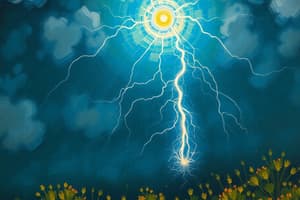Podcast
Questions and Answers
What constitutes the basic structural unit of an element?
What constitutes the basic structural unit of an element?
- Atom (correct)
- Ion
- Molecule
- Compound
Which of the following is a characteristic of ionic bonds?
Which of the following is a characteristic of ionic bonds?
- Always occurs in water
- Formation of positive and negative ions (correct)
- Requires two atoms of the same element
- Involves the sharing of electrons
What is the role of buffers in biological systems?
What is the role of buffers in biological systems?
- They store genetic information
- They maintain a stable pH (correct)
- They act as building blocks for proteins
- They speed up chemical reactions
How many elements primarily make up over 90% of the human body?
How many elements primarily make up over 90% of the human body?
What type of bond is formed when atoms share electrons to fill their valence shells?
What type of bond is formed when atoms share electrons to fill their valence shells?
What characterizes hydrogen bonds?
What characterizes hydrogen bonds?
How do acids behave when dissolved in water?
How do acids behave when dissolved in water?
Which of the following statements about buffers is true?
Which of the following statements about buffers is true?
What is the primary effect of water acting as a solvent?
What is the primary effect of water acting as a solvent?
How is the pH scale defined?
How is the pH scale defined?
Which of the following are considered potential laboratory hazards? (Select all that apply)
Which of the following are considered potential laboratory hazards? (Select all that apply)
It is safe to consume food in the laboratory.
It is safe to consume food in the laboratory.
Lab coats ______ an important part of safety when conducting lab exercises.
Lab coats ______ an important part of safety when conducting lab exercises.
What should you do immediately if your lab coat catches fire?
What should you do immediately if your lab coat catches fire?
What is the proper way to dilute concentrated acids?
What is the proper way to dilute concentrated acids?
What is the primary purpose of a biohazard bin?
What is the primary purpose of a biohazard bin?
Good hand washing technique is essential to avoid ________ in the lab.
Good hand washing technique is essential to avoid ________ in the lab.
What should you do if there is a lab emergency?
What should you do if there is a lab emergency?
What should be done before and after every lab experiment?
What should be done before and after every lab experiment?
Gloves should touch door handles and other common surfaces while in the lab.
Gloves should touch door handles and other common surfaces while in the lab.
When working with open flames, tie back ______ hair.
When working with open flames, tie back ______ hair.
What is the primary reason for wearing closed-toed shoes in the laboratory?
What is the primary reason for wearing closed-toed shoes in the laboratory?
What must you do with reusable materials that require sterilization?
What must you do with reusable materials that require sterilization?
Flashcards are hidden until you start studying
Study Notes
Matter and Elements
- Matter is anything that has mass and occupies space.
- Elements are the fundamental building blocks of matter and cannot be broken down further by chemical means.
- Four elements, carbon (C), nitrogen (N), oxygen (O), and hydrogen (H), constitute over 90% of the human body.
Atoms
- An atom is the smallest unit of an element that retains its chemical properties.
- Atoms consist of three subatomic particles: protons, neutrons, and electrons.
Molecules and Compounds
- Molecules are formed when atoms bond together.
- Molecules can be composed of the same atom (e.g., O2) or different atoms (e.g., H2O).
- Compounds are molecules made up of different types of atoms (e.g., H2O).
Ionic Bonding
- Atoms strive for stability when their outer electron shell (valence shell) is full.
- In ionic bonding, atoms donate or accept electrons to achieve a full valence shell.
- This results in the formation of charged particles called ions (positive or negative).
- The electrostatic attraction between oppositely charged ions creates an ionic bond.
Covalent Bonding
- Covalent bonding involves the sharing of electrons between atoms.
- Each atom contributes one electron to the shared pair.
- Electrons are shared in the valence shells of both atoms involved in the bond.
- Double covalent bonds share two pairs of electrons, while triple covalent bonds share three electron pairs.
Hydrogen Bonds
- Hydrogen bond is an attraction between a slightly positive hydrogen atom and a slightly negative oxygen or nitrogen atom.
- These bonds are relatively weak.
- They play a crucial role in the structure and function of many biological molecules.
Water as a Solvent
- Water is a polar molecule, meaning it has a slightly positive and slightly negative end.
- Water's polarity makes it an excellent solvent, dissolving many substances.
- A solution is a mixture of water with dissolved solutes.
- Salts dissociate or separate when dissolved in water, facilitating chemical reactions.
Hydrophilic and Hydrophobic Molecules
- Polar molecules like water attract water and are considered hydrophilic.
- Nonpolar molecules do not attract water and are hydrophobic.
Acids
- Acids are substances that release hydrogen ions (H+) when dissolved in water.
- For example, hydrochloric acid (HCl) is produced in the stomach and aids in digestion.
Bases
- Bases are substances that accept hydrogen ions (H+) or release hydroxide ions (OH-) when dissolved in water.
- For example, sodium hydroxide (NaOH) is a strong base.
The pH Scale
- The pH scale is a measure of the acidity or alkalinity (basicity) of a solution.
- It ranges from 0 (very acidic) to 14 (very basic).
- A pH of 7 is neutral, where the concentration of hydrogen ions (H+) equals that of hydroxide ions (OH-).
- Solutions with a pH below 7 are acidic (H+ > OH-) and above 7 are basic (OH- > H+).
Buffers
- Buffers are solutions that resist changes in pH when acids or bases are added.
- Their role is crucial in biological systems where pH values need to be maintained within a narrow range.
- Buffers establish an equilibrium between a conjugate acid/base pair.
- A buffer system can consist of a weak acid and its corresponding salt (conjugate base) or a weak base and its salt (conjugate acid).
Buffer Capacity
- Buffer capacity refers to the ability of a solution to resist large changes in pH when a strong acid or base is added.
Biomolecules
- The four major organic molecules found in living organisms are carbohydrates, lipids, proteins, and nucleic acids.
- Each biomolecule is composed of subunits.
Dehydration and Hydrolysis Reactions
- Dehydration reaction is a synthesis reaction that removes water to link subunits together and form macromolecules.
- Hydrolysis reaction involves the addition of water to break down macromolecules into their subunits.
Carbohydrates
- Function as an energy source.
- Simple sugars (monosaccharides) include glucose, fructose, and galactose.
- Disaccharides are formed when two monosaccharides are joined by a dehydration reaction; examples include sucrose (table sugar) and lactose (milk sugar).
- Polysaccharides (complex carbohydrates), such as starch, glycogen, and cellulose, are long polymers of glucose subunits.
Proteins
- Proteins are polymers composed of amino acid subunits.
- Each amino acid has an amino group, a carboxyl group, and a unique R group.
- Three or more amino acids linked together form a polypeptide.
- The bond between two amino acids is called a peptide bond.
Protein Shape and Function
- A protein's three-dimensional shape is critical for its function.
- Denaturation refers to a change in protein shape due to extreme heat or pH, which disrupts its function.
Lipids
- Lipids are biomolecules soluble in nonpolar solvents.
- They include triglycerides (fats and oils), phospholipids, and steroids.
Triglycerides (Fats and Oils)
- Triglycerides are composed of one glycerol molecule and three fatty acids.
- Fats are typically of animal origin and solid at room temperature, while oils are mainly derived from plants and are liquid at room temperature.
- Triglycerides are hydrophobic.
- Emulsifiers are molecules that surround triglycerides and disperse them, preventing the separation of fats and water.
Phospholipids
- Phospholipids have a structure similar to triglycerides but with one fatty acid replaced by a polar phosphate group.
- They have a polar, hydrophilic head and nonpolar, hydrophobic tails.
- Phospholipids are the primary components of cell membranes.
Steroids
- Steroids are lipids composed of four fused carbon rings.
- They include cholesterol, which is the precursor to other steroids like sex hormones.
Nucleic Acids
- Nucleic acids are polymers of nucleotides.
- Each nucleotide consists of a phosphate group, a five-carbon sugar, and a nitrogenous base.
Lab Safety
- The lab presents several risks including corrosive chemicals, sharp objects, open flames, and infectious organisms.
- Microorganisms are classified into four biosafety levels (BSL) based on their transmissibility and pathogenicity.
- BSL 1 organisms are those that usually do not cause disease in healthy individuals.
- BSL 4 organisms like Marburg and Hantavirus require specialized labs and extensive safety measures.
Standard Practices
- Lab coats should be worn to protect from contamination but are not chemical protection suits.
- Gloves should be worn to protect hands but should never touch common surfaces outside of the lab.
- Food, drink, and chewing gum is strictly prohibited in the lab.
- Makeup and contact lens adjustment is also prohibited in the lab.
- Keep the lab bench clean and avoid leaving active experiments unattended.
- Disinfect the benchtop before and after each lab experiment.
- Long hair and loose clothing should be secured when working with open flames.
- Goggles, safety glasses or face shields are required when working with sources of splashing chemicals or aerosols like UV light.
- Wear closed toed shoes in the lab to protect against chemical spills and sharp objects.
- Report any spills, accidents, or injuries to the instructor immediately.
Safety Equipment
- Know the location of safety equipment like eyewash stations, chemical showers, first aid kits, and fire extinguishers.
- Utilize fume hoods or biosafety cabinets when instructed.
- Chemical hygiene plans are often developed by institutions to protect lab personnel.
Waste Disposal
- Dispose of biohazardous waste in appropriately labeled bins or bags.
- Place contaminated items like gloves in the biohazard bin.
- Use sharps containers for broken glass, needles, scalpel blades, and glass pipettes.
- Place non-contaminated waste in regular trash cans.
- Autoclave reusable materials that require sterilization.
- Wash reusable materials that do not require sterilization in the sink.
Chemical Handling
- Keep chemical containers closed.
- Never use unmarked or unknown reagents.
- Bottles should be carried using suitable arrangements, not by the neck.
- When pouring chemicals, the label should face upwards to prevent damage.
- Never put chemicals in a bottle not indicated on the label.
- Dilute acids by slowly pouring acid into water, stirring continuously.
Handwashing
- Wash hands prior to and after each lab exercise, and anytime hands have been in contact with potential hazards.
- Wash hands thoroughly following CDC guidelines:
- Remove jewelry.
- Wet hands with running water and apply soap.
- Rub hands together to make a lather.
- Scrub hands for at least 20 seconds, singing “Happy Birthday” twice.
- Rinse hands thoroughly.
- Dry hands with a clean towel or air dry.
Metric Systems
- Scientists typically use the SI (International System of Units).
- The SI system is based on the number 10.
- The SI system is used for measuring length, mass, and volume using prefixes like “micro”.
Studying That Suits You
Use AI to generate personalized quizzes and flashcards to suit your learning preferences.




